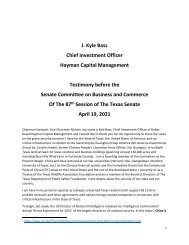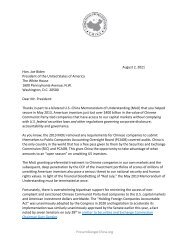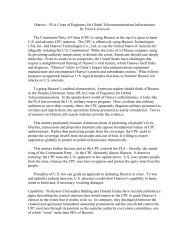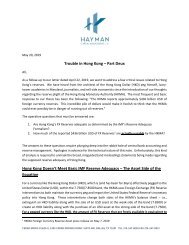You also want an ePaper? Increase the reach of your titles
YUMPU automatically turns print PDFs into web optimized ePapers that Google loves.
<strong>The</strong> Economics Beh<strong>in</strong>d Currency Boards/Pegs<br />
<strong>The</strong> harsh reality is that economic relationships between pegged regimes must be harmonized or they are<br />
dest<strong>in</strong>ed to fail. Norman Chan, the soon-to-be-retired CEO of the HKMA, admitted this <strong>in</strong> 2017 when he<br />
set the four conditions that need to be present for the <strong>Hong</strong> <strong>Kong</strong> Dollar to be reset and re-pegged to the<br />
Ch<strong>in</strong>ese RMB.<br />
Bus<strong>in</strong>ess cycles and economies must be synchronized or stresses will emerge <strong>in</strong> the fixed nature of a<br />
currency board or peg. If one of the economies is grow<strong>in</strong>g while the other is contract<strong>in</strong>g (one demands<br />
higher <strong>in</strong>terest rates while the other needs lower <strong>in</strong>terest rates), the resultant lack of synchronicity of<br />
pegged economies <strong>in</strong> a rigid exchange regime builds pressure-cooker like imbalances over time. <strong>The</strong><br />
economy that has elected to peg (HK) to the anchor currency (USD) must import (or mirror) the monetary<br />
policy (primarily <strong>in</strong>terest rates) of that country. This means that if overnight rates diverge between the<br />
two, the divergence will cause large capital flows one way or the other, which immediately puts pressure<br />
on the currency board/peg. On the strong side of the peg (ie when outside capital is flow<strong>in</strong>g <strong>in</strong>to the<br />
pegged currency), the central bank can easily flood the system with liquidity (pr<strong>in</strong>t local currency) to lower<br />
rates and discourage additional capital flows <strong>in</strong>to the pegged currency. On the weak side of the<br />
board/peg, the pegged regime can spend available excess reserves (th<strong>in</strong>k ra<strong>in</strong>y day sav<strong>in</strong>gs) to defend the<br />
peg. If currency boards were perfect, the Argent<strong>in</strong>ian Peso would be still be 1-to-1 to the US Dollar like it<br />
was <strong>in</strong> 2001. Instead, today it takes 43 pesos to buy one dollar.<br />
10<br />
© Hayman Capital Management, L.P. <strong>2019</strong>






